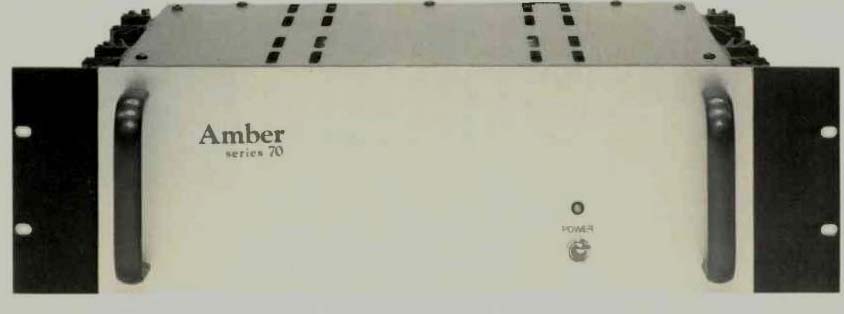
Manufacturer's Specifications:
Power Output: 70 watts per channel, 8-ohm loads, from 20 Hz to 20 kHz; 100 watts per channel, 4-ohm loads, from 20 Hz to 20 kHz.
Rated THD: 0.1% (8 ohms), 0.25% (4 ohms).
SMPTE IM Distortion: 0.03%.
Frequency Response: 5 Hz to 100 kHz, +0, -3.0 dB.
Slew Rate: Greater than 20 V/µS.
S/N Ratio: 90 dB re: rated output.
Input Impedance: 100 kilohms.
Input Sensitivity: 1.15 V rms for 70 watts/8 ohms; 1.0 V rms for 100 watts/4 ohms.
Power Requirements: 120 V a.c., 50/60 Hz, 350 watts maximum (25 watts idle).
Dimensions: 19 in. (48.3 cm) W x 5 1/4 in. (13.3 cm) H x 11 1/2 in. (29.2 cm) D.
Weight: 35 lbs. (15.75 kg).
Price: $549.00.
Amber Electronics, an audio equipment manufacturer located in Charlottesville, Virginia, informs us that this amplifier, as well as all of their other products, has been completely designed and manufactured in the United States. The Series 70 amp is a basic power amplifier that operates with either 8- or 4-ohm loads in stereo and can also be operated in a bridged or mono mode, under which conditions its rated power output increases to 200 watts into an 8-ohm load with no more than 0.25% harmonic or IM distortion.
The front panel of the amplifier contains no controls other than a power on/off switch and an indicator light which illuminates when power is turned on. The back panel is equipped with all of the necessary input and output terminals.
Phono tip jacks are used as input terminals, while five-way, 3/4-inch spaced binding posts, color coded for polarity, are used for speaker connections. These will accept standard double banana plugs, but stripped ends of speaker cables can easily be connected directly to the terminals. There are no fewer than seven fuse holders on this surface as well. Four of these take care of the positive and negative legs of each channel's high voltage (B+ and B-) supplies, another pair is in the positive lines of the speaker outputs, while the final fuse is a 4-ampere, slow-blow line fuse. The speaker fuses, as supplied by Amber, are 3-ampere types, although the brief, four-page owner's booklet which accompanies the amplifier includes a table of fuse values that may be substituted, depending upon speaker impedance and power handling capacity.
No schematic diagram was included with the Series 70 amplifier, but according to the owner's booklet and from observation of the amp's construction, there are no capacitors in feedback loops and no parallel output devices. A low-pass filter excludes signals above 100 kHz, thereby eliminating the possibility of slew-limiting distortion and TIM. (There are those who have argued that bandwidth limiting is not the way to reduce these problems, but we'll leave that to the audio philosophers.) A high-pass filter is used to block d.c. transients from being amplified, and I don't think anyone will argue against keeping d.c. away from speaker voice-coils if at all possible! The amplifier is constructed in a modular fashion so that all circuit components, with the exception of the power supply, are mounted on replaceable p.c. boards measuring about four inches square. The chassis is made of 16 gauge steel and has, I am told, over six square feet of heat-sink area. Components seemed to be of the highest quality and were, in general, close-tolerance types wherever such tolerances are needed.
Measurements
Figure 1 is a plot of power output versus THD, for both 8- and 4-ohm loads. With 8-ohm loads, using a 1-kHz signal, the amplifier delivered 73.2 watts per channel at the rated THD level of 0.1%, while with 4-ohm loads, the rated THD level of 0.25% was reached when output power was 108 watts per channel. Figure 2 plots SMPTE-IM distortion as a function of output power and results were quite similar, with 78 watts per channel delivered for the rated IM level with 8-ohm loads and 108 watts per channel obtained under 4-ohm load conditions. Using the FTC power rule as a criterion, I agree with Amber that the rated power output (under 8-ohm load conditions) for this amplifier could not have exceeded 70 watts per channel, for at 20 kHz, as we see in Fig. 3, 70 watts of output did produce the rated THD level of 0.1%. Harmonic distortion at 20 kHz is a meaningless term as far as human hearing is concerned but that's the rule, and Amber is abiding by it. In fact, under musical conditions, the Series 70 exhibited a full 1 .0 dB of dynamic headroom, which is not a very big headroom number but nevertheless means that for short, musical transient signals operating into 8-ohm loads, the amplifier can deliver as much as 88 watts or so per channel without audible clipping.
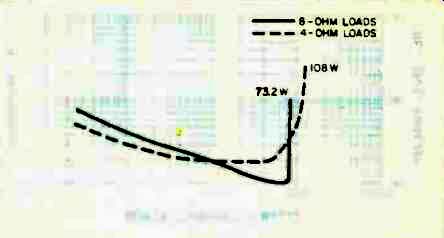
Fig. 1--Harmonic distortion vs. power output at 1 kHz.
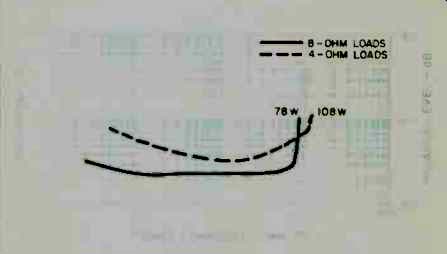
Fig. 2--SMPTE IM distortion vs. power output.
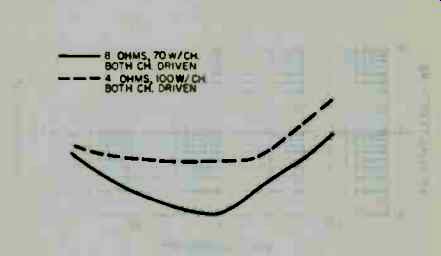
Fig. 3--Distortion vs. frequency.
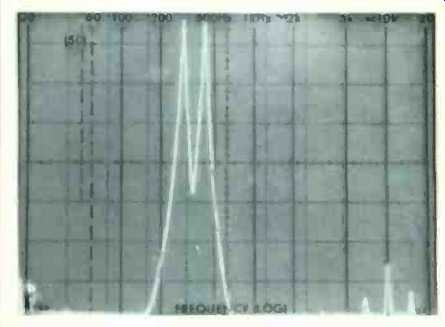
Fig. 4--Twin-tone IM measurement revealing a small amount of IHF IM distortion
within the audible spectrum. Note: Sweep is linear, from 20 Hz to 20 kHz,
so log scale at top of display should be ignored (see text).
Damping factor (again using 8-ohm loads as a reference) measured around 90 for a 50-Hz test signal. Input sensitivity for rated output was exactly 1.1 volt, while A-weighted signal-to-noise ratio, referred to the 70-watt rated output, measured 105 dB considerably better than the 90 dB claimed by Amber. I wonder if they are measuring S/N according to IHF standards, since 90 dB for a power amp is hardly anything to brag about these days. Slew rate did measure approximately 20 volts per microsecond, as claimed. As for frequency response, it extended from 6 Hz to 30 kHz for a -1 .0 dB roll-off point or from 3.0 Hz to 100 kHz for the -3 dB roll-off point. CCIF IM distortion (the production of a 1-kHz IM tone when two high-frequency tones separated by that frequency are applied to the amp simultaneously) measured a very low 0.0014%, but IHF IM, though still quite low, was measurable at 0.06% when the twin tones used were at 9 kHz and 10 kHz as shown in Fig. 4. In this display, sweep is linear from 20 Hz to 20 kHz (ignore the log-type frequency notations at the top of the display). The large spikes near the center are the desired output signals at frequencies of 9 and 10 kHz, and their amplitude is the equivalent (added together) of 70 watts rated output. The unwanted components generated at the right of the display at 16, 17 and 18 kHz are summed mathematically (the square root of the sum of the squares of their amplitudes) and expressed as a percentage of the reference rated output level to arrive at an IHF IM figure of 0.06%.
Use and Listening Tests
The sounds delivered via reference speakers when driven by the Amber Series 70 power amplifier were altogether neutral in character, and, despite the bandwidth restrictions imposed by the designers, I could detect no problems with musical transient reproduction or with any sort of dynamic forms of inter modulation. I listened to the amplifier at low power output levels in an effort to detect any evidence of notch or switching distortion and could detect none of these effects either. The amplifier ran quite cool, even after several hours of reproducing program material in my listening room at fairly loud volume levels using reference speakers not particularly noted for their high efficiency.
It's nice to find a young company turning out good audio equipment in as unlikely a place as Charlottesville, Virginia, and I certainly wish them every success with this product as well as with future ones. If I might make one suggestion an amplifier expected to retail for nearly $500.00 deserves more than the little four-page 8 1/2 x 5 1/2 pamphlet as an owner's manual. There's a lot more they could have told the user about the amplifier that would have instilled confidence in its use. After all, not everyone buying it will put it through the tough lab tests that I did.
-Leonard Feldman
[ Adapted from Audio magazine/Feb. 1982]
Also see:
Amber Model 7 Tuner and Model 50b Amplifier (Aug. 1985)
Acoustat Trans-Nova Twin-200 Power Amplifier (Mar. 1983)
Audio Research M-300 Amplifier (Nov. 1988)
= = = =